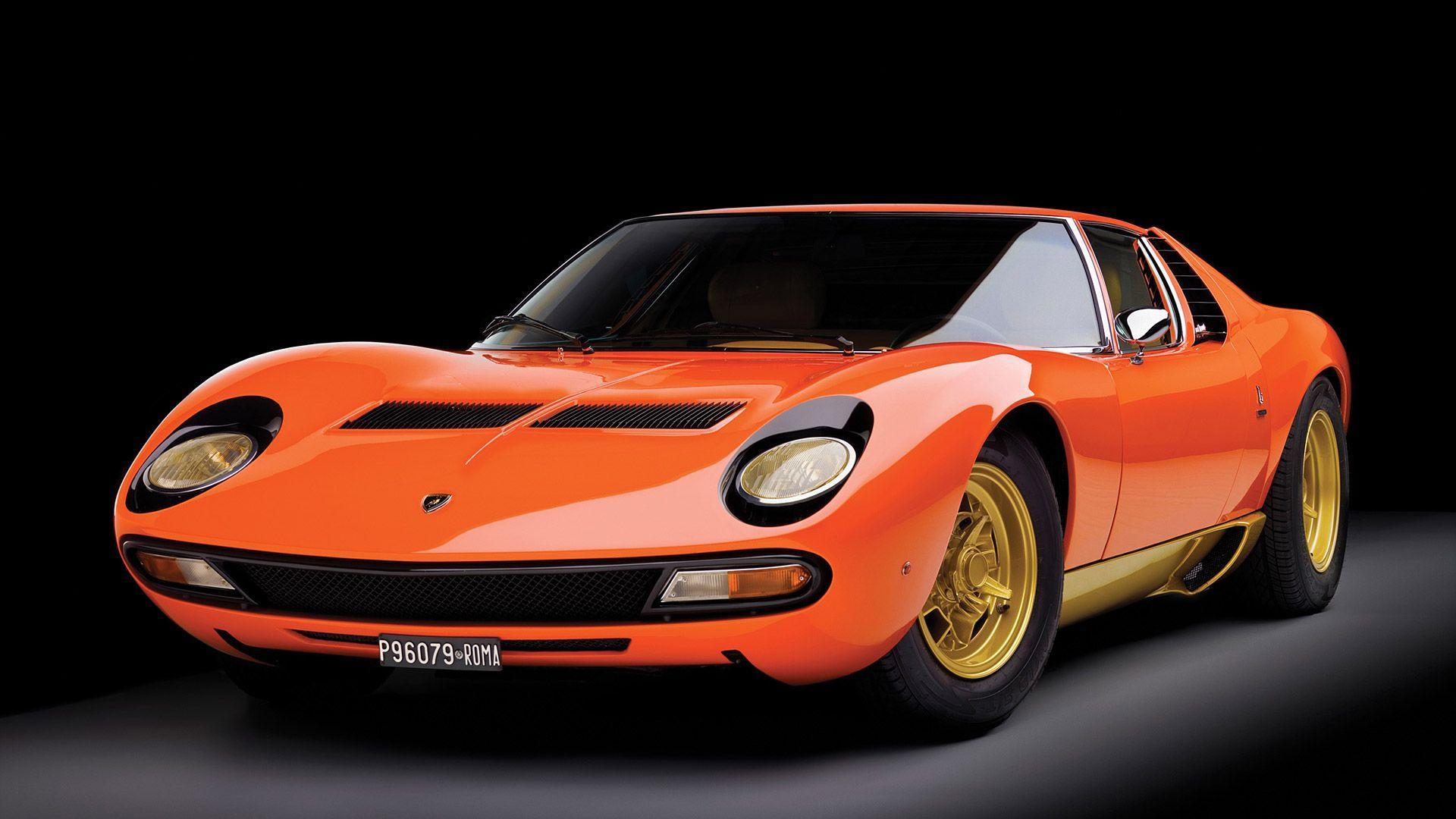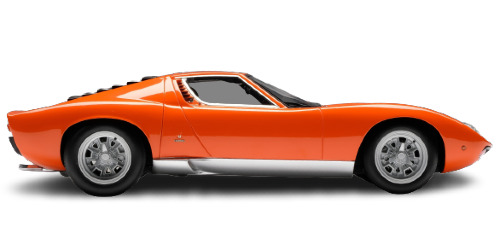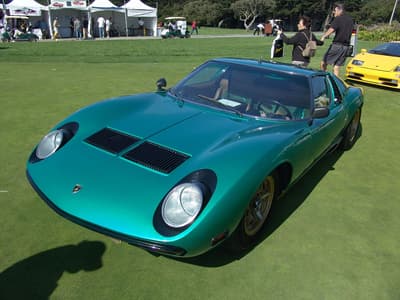The final evolution of the Miura was presented in 1971 as the SV, which stood for Spinto Veloce, it didn’t look like it at first glance, but the SV was a major improved over the S-model, and not only because of those muscular looking, wide wheel arches at the back.
The ventilated discs that appeared on the later S-models were again standard, and the chassis was further improved to offer more rigidity to cope with the extra power from the V12 engine that now pumped out 385 bhp at 7850 rpm.
On the Miura SV the engine oil and the gearbox oil were finally separated, this made the use of specific oils possible for optimal lubrication in these areas, some SV’s were even ordered with dry-sump lubrication and a self-blocking differential, which were the only available options at that time.
This separate lubrication wasn’t introduced until late 1971, so the first Miura SV’s weren’t equipped with it, the ZF-self-blocking differential was strictly optional at 275,000 Liras and was only installed on a few SV’s with features specified by the customer and only on the SV’s with dry-sump lubrication.
On the outside the most striking difference was the bulging of the rear wheel arches, they had to be widened by 13 cm compared to the S-model as the Miura SV was fitted with the new Pirelli’s. Subsequently the suspension geometry was changed from lower triangles to lower quadrilaterals, because of these new tires the track had to be widened which needed the wheel arches to be redesigned, subsequently making the Miura SV look even more intimidating.
The grill around the front headlamps was removed and the front air intakes were different, the interior became upholstered in real leather, it used to be leather-looking vinyl on the earlier Miura, and the air-conditioning became standard too, finally.
The Miura SV was the fastest production car in existence at that time, and it would remain the fastest until the introduction of the Countach. But the SV wasn’t faster than the S because the wider tires didn’t allow a higher top speed despite an increase in horsepower.
The Miura SV was in fact not a true production Lamborghini, it was built on special order only, and therefore available in very limited numbers, after being in production for 18 month Ferruccio Lamborghini ceased production after a total of 150 SV were built. Today the Miura SV has become a true collector’s item, and prices for a decent SV are all in the higher region, an excellent Miura SV easily costs more than several brand new Aventador recently a 1971 Miura SV sold for USD 1,700,000 at an auction making it the most expensive, classic Bull ever.
The Miura SV is probably the best Miura from the series, and with only 150 made one of the rarest too, yes the Miura S was built only 140 times, but take into account several SV were converted during their life, some into SVJ editions, while other have been crashed beyond repair although the latter is a matter of semantics as a car can be built up again these days from only a plaque with a chassis number if funds are available.
Originally the production of the Miura SV was halted in October 1973 as Ferruccio had the idea people were no longer interested in the Miura after seeing the Countach prototype at the same auto show that introduced the Miura SV, the 1971 Geneva Auto Show but it would take Lamborghini several more months to have the Countach LP400 available for delivery. One of the final production Miura SV was a black finished SV with a light-toned interior, it beared chassis number 5110 and was ordered by the son of Innocenti.
The car was later sold to Max Bobnar, a member of the Swiss Lamborghini Club, this late SV is still in perfect running condition today while it was actually finished in January 1973 and according to official factory documentation only three more Miura would be built after this one.
As usual with Lamborghini history nothing is perfectly clear with regards to numbers and dates, however several sources state the very last Miura SV wasn’t assembled until April 1975, this car with chassis number 5092 was rumored to be completely built up from spare parts on special order for Walter Wolf, a long time Lamborghini fan and owner of several custom made Countach models, this Miura SV however was to be a present for his wife.
Trying to buy a Lamborghini Miura SV these days will take a lot of courage and even more money, you either pay a small fortune to get one in perfect condition or you end up paying an even larger fortune trying to revive a deceased one either way a Miura will be an expensive car to obtain and maintain. But one thing is sure the Lamborghini Miura, be it the original P400, the S-model or this latest SV evolution, is a sure investment, this is an icon in automotive history, it not only put Automobili Lamborghini SpA firmly on the cover page of every car magazine in the world, but it also created the foundation for the Lamborghini heritage we still enjoy today.
The Miura was the first of the Lamborghini line that stepped away from the ultra quick but comfortable Gran Turismo right into the super car league and the heritage lived on in the legendary Countach over the by now classic Diablo straight into the more recent Murciélago only to reside now in the Aventador another masterpiece that has become a reference to which the competition if any has to measure up the V12 flagship models from Sant’Agata all became legends in their own time and the new Aventador LP700 is no different.
| Specifications | Lamborghini Miura P400 SV |
|---|---|
| Production Years | 1971-1973 |
| Engine | 3.9 L V12 |
| Power | 385 hp @ 7,850 rpm |
| Torque | 294 lb-ft @ 5,750 rpm |
| Top Speed | 180 mph (290 km/h) |
| 0-60 mph | 5.8 seconds |
| Transmission | 5-speed manual |
| Brakes | Four-wheel disc brakes |
| Curb Weight | 2,866 lbs (1,300 kg) |
| Length | 170.5 inches (4,330 mm) |
| Width | 70.9 inches (1,800 mm) |
| Height | 42.1 inches (1,070 mm) |
| Wheelbase | 98.4 inches (2,500 mm) |
| Fuel Capacity | 100 L (26.4 gal) |
| Tires | Front: 205/70VR14, Rear: 215/70VR14 |
| Suspension | Independent suspension, coil springs, telescopic shock absorbers |
| Steering | Rack-and-pinion |




